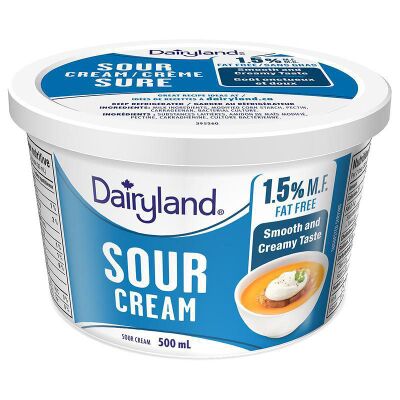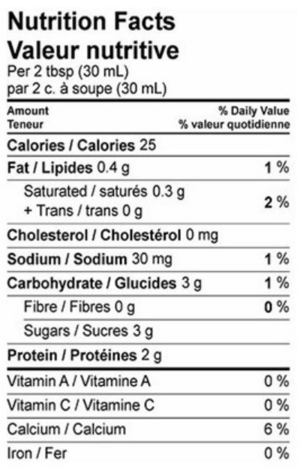Course:FNH200/Assignments/2022/Dairyland Sour Cream vs Dairyland Fat Free Sour Cream
Introduction
Sour cream is characterized by a tangy taste that complements many dishes, sauces, and even desserts. Bacterial culture is added to pasteurized cream to produce lactic acid, which causes a coagulation of the proteins found in cream. The lactic acid and its interaction with proteins creates thickness and the sour taste. Together with approved additives, the taste, mouth-feel, and shelf-life of sour cream are enhanced. As consumers become more health-aware, more purchase products with fat-free alternatives. This page will explore the food science and food safety in the manufacturing of commercial sour cream.
A comparison will be made between Dairyland 14% Milk Fat Sour Cream and Dairyland 1.5% Milk Fat Sour Cream. Dairyland is a beloved Canadian company based in British Columbia whose products can be found in many supermarkets nationwide. A comparison between their regular sour cream and their fat-free alternative will equip consumers to make more informed food choices about this Canadian staple.
Product Images




Ingredient lists
Table 1. Ingredient comparison between Dairyland sour cream regular and fat free.
| Dairyland Sour Cream Regular (14% M.F.)[2] | Dairyland Sour Cream Fat Free 1.5% M.F., 500 Millilitre[3] |
| Milk ingredients
Modified corn starch Bacterial culture Carrageenan Modified milk ingredients Guar gum Sodium citrate Calcium sulphate Disodium phosphate |
Milk ingredients
Modified corn starch Bacterial culture Carrageenan Pectin |
Table 2. Identified fat substitutes, sugar substitutes, and/or additives used.
| Dairyland - Regular (14% M.F.) Sour Cream | Dairyland - Sour Cream Fat Free (1.5% M.F.), 500 Millilitre | |
|---|---|---|
| Fat substitutes |
|
|
| Sugar substitutes |
|
|
| Additives |
|
|
Table 3. Roles of fat substitutes, sugar substitutes, and/or additives.
| Fat Substitutes | Roles |
|---|---|
| Pectin |
|
| Additives[4] | Roles |
| Modified Corn Starch |
|
| Carrageenan |
|
| Modified Milk Ingredient |
|
| Guar gum |
|
| Bacterial culture |
|
| Sodium citrate |
|
| Calcium sulphate |
|
| Disodium phosphate |
|
Compare and Contrast
Dairyland manufactures both regular-fat and fat-free products to have a similar texture and taste, by using other alternative ingredients. Table 1 lists the ingredients of regular and fat-free sour cream. As can be seen, the regular sour cream contains more additives: modified milk ingredients, guar gum, sodium citrate, calcium sulphate, and disodium phosphate. In comparison, the fat-free sour cream has pectin added to provide a texture (creamy and mouth-feeling) similar to the fat in regular sour cream. The pectin used could be extracted from the apple and citrus fruits.[8]
Labels
| Requirements | Dairyland - Regular (14% M.F.) Sour Cream | Dairyland - Sour Cream Fat Free (1.5% M.F.), 500 Millilitre |
|---|---|---|
 |
 | |
| Bilingual Labelling | The label has bilingual labelling with both languages of English and French. | The label has bilingual labelling with both languages of English and French |
| Common name of the food | The common name is Sour Cream. | The common name is Sour Cream. |
| Principle Place of Business | The company, Dairyland Canada, operates from British Columbia | The company, Dairyland Canada, operates from British Columbia |
| Legibility and location | The label is legible and the information is easy to locate on the packaging. The product is made in Canada | The label is legible and the information is easy to locate on the packaging. The product is made in Canada |
| Date marking and storage instructions | Because the shelf life of sour cream is less than 90 days, there is a date marking the shelf life and storage instructions available. For this particular product, storage instructions are “Keep Refrigerated” | Because the shelf life of sour cream is less than 90 days, there is a date marking the shelf life and storage instructions available. For this particular product, storage instructions are “Keep Refrigerated” |
| Net quantity | The net quantity is 750 ml | The net quantity is 500 ml |
| List of ingredients | List of ingredients under nutritional facts table.[2]
|
List of ingredients under nutritional facts table.[3]
|
| Irradiated Foods | Not applicable to this product | Not applicable to this product |
| Sweeteners | Not applicable to this product | Not applicable to this product |
| Other information | On the container lid, the name, the manufacturer, and the milk fat percentage are all present. The label on the regular sour cream container states the the milk fat percentage is 14%, which follows the regulatory guidelines required for some milk products where the milk fat percentage must be stated. | On the container lid, the name, the manufacturer, and the milk fat percentage are all present.The label on the regular sour cream container states the the milk fat percentage is 1.5%, which follows the regulatory guidelines required for some milk products where the milk fat percentage must be stated. |
| Nutrition Facts labelling | It is clearly shown and adheres to all presentation of the nutrition facts table requirements. | It is clearly shown and adheres to all presentation of the nutrition facts table requirements. |
| Food additives | All additives listed in list of ingredients in accordance to the December 14, 2016 amendments to nutrition labelling. | All additives listed in list of ingredients in accordance to the December 14, 2016 amendments to nutrition labelling. |
| Fortification | Not applicable, not fortified | Not applicable, not fortified |
| Grades | Not applicable | Not applicable |
| Standards of identity | Unstandardized | Unstandardized |

The information stated above follows the regulatory requirements/guidelines set by the Consumer Packaging and Labelling Act and Regulations and in lesson 4.
References
- ↑ Wong, Andrew (July 15, 2021). "Ingredient sour cream".
- ↑ 2.0 2.1 "Dairyland 14% Sour Cream". Walmart. Retrieved July 17, 2022.
- ↑ 3.0 3.1 "Dairyland Fat Free Sour Cream". Walmart. Retrieved July 17, 2022.
- ↑ Government of Canada. [(https://laws-lois.justice.gc.ca/eng/regulations/C.R.C.,_c._870/page-43.html#h-573289) "Division 16: Food Additives"] Check
|url=value (help). Retrieved July 15, 2022. - ↑ "Modified Food Starch Demystified". Bob's Red Mill. 2012, May 16. Retrieved July 16, 2022. Check date values in:
|date=(help) - ↑ Heather, McClees (2017, May 25). "Why You Should Check Your Cheese, Creamer, and Non-Dairy Milk Labels for This Scary Ingredient". One Green Planet. Check date values in:
|date=(help) - ↑ "What are "modified milk ingredients"?". Office for Science and Society. 2022, February 4. Check date values in:
|date=(help) - ↑ Chan, Judy. (2022) 2.2.1.1 "Carbohydrates". Canvas. Retrieved July 18, 2022.
- ↑ Wong, Andrew (July 15, 2021). "Ingredient sour cream".
| This Food Science resource was created by Course:FNH200. |
